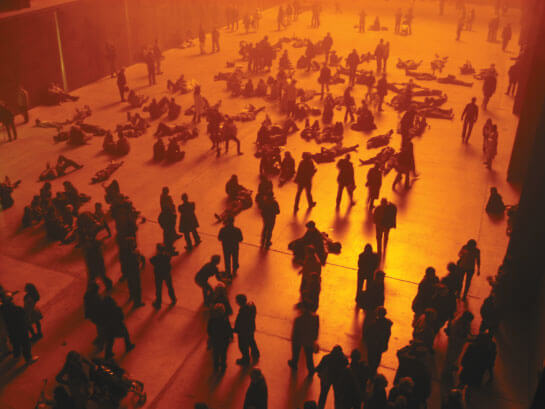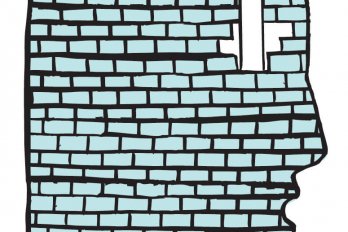A news release from London’s premiere modern art gallery in the winter of 2003 reported, “One million people visit the sun at Tate Modern.” The improbable draw was The Weather Project, an installation by Danish art star Olafur Eliasson. Crowds streamed to the gallery’s immense Turbine Hall on the south bank of the Thames, where they discovered a cavernous indoor space illuminated by the artificial rays of Eliasson’s giant indoor sun. The illusion of warmth transformed this former industrial site into an inviting microclimate replete with the changeability typical of the weather in England. Fogs appeared and dissipated, distributing the pervasive yellow light. Serious visitors responded to this new amenity with contemplative awe. Others saw it as a welcoming public playground.
Is there not something odd about going to an art gallery to bask in the light of an artificial sun? Jokes about the need to escape the English weather aside, how do we explain this attendance record at a presentation of nature indoors? Nor was Eliasson’s remarkable project unique in attracting crowds. In Ottawa, Toronto, and New York City, art and nature lovers have been queuing to see Toronto-based photographer Edward Burtynsky’s Manufactured Landscapes, images that seduce us with the accidental beauty of environmental destruction around the globe. We see strip mines, shipbreaking, and mammoth industrial projects, again from within the security and comfort of a museum.
Worldwide, millions flock to art museums to see what we would normally think of as wholly beyond our control. In smaller numbers, but with great conviction, hardcore art viewers also seek out natural experiences in the most contrived, high-tech creations of recent “land art,” such as James Turrell’s majestic Roden Crater in the Arizona desert. But what we see in the reactions to Eliasson and Burtynsky is new. It is more than a symptom of our nostalgia for a benevolent nature and of our fears about the destruction of the environment. It is a sign of confusion about what and where nature is. With Eliasson and Burtynsky, we are keenly aware of the extent to which humans make or break nature. We are no longer entirely at the mercy of the forces of nature; nature is governed and sustained by our values and actions. We revel in the details, and what we see yields anxiety, yet the popularity of these exhibitions suggests more than group self-flagellation. Rather than dwell on its calamities, we hope to make nature an integral part of contemporary experience.
People have enjoyed nature in the form of landscape paintings since Roman times. In eighteenth-century London, Philippe Jacques de Loutherbourg charged admission to the Universal Studios experience of the day, theatrical re-enactments of earthquakes, Niagara Falls, and other sublime phenomena wrought by his elaborate con-traption for creating 3-D spectacles, the Eidophusikon, a “living picture apparatus.” The corollary to these artificial experiences is equally familiar. Eighteenth- and nineteenth-century European landscape gardens were designed to be “picturesque,” to look like landscape paintings. But where nature and art intriguingly mimicked one another in earlier times, leading us to revelations both about ourselves and about nature, more and more today the distinction between nature and culture is blurred.
The Olafur Eliasson of contemporary thought, Bruno Latour, is a colourful and often controversial French philosopher of nature who has come to prominence by challenging the certainties and sway of science in the West. He doesn’t mind being outrageous to get our attention. We should live without the nature/culture dichotomy, he proposes, not because external reality is an illusion, but because the assumption that nature is an independent realm of immutable scientific facts and laws undermines the creation of the kind of engaged, democratic societies on which the future of our planet depends. Latour is a pioneer in science studies, an interdisciplinary terrain that deploys tools from both the human and social sciences to fathom how technology and science function in society. In Politics of Nature, he argues that nature is inside us, that it is thoroughly mediated by human technologies. Take the weather, as Eliasson did. Our understanding of its phenomena is achieved largely through a complex relay of satellite data, images, and the personality at the weather desk. However destructive and beyond our control it may be, what we think of as the weather is no simple fact, nor is it solely what happens outside.
Latour wants to shift us from our everyday experiences of nature to a new plane of coexistence. “As we get closer to matters of fact,” he holds, “they become matters of concern.” That is, nature’s truths are arrived at in human communities and in human terms, which render nature largely artificial. The certainties of an earlier view of nature, and the fact that knowledge of those truths tends to concentrate among a small, elite group of experts, foreclose real public discussion. How can one argue with or about a natural law? As a matter of common concern, however, nature brings us inside disputes and allows us to become active participants. We can and should find a successor to our relationship to nature as it has evolved as a human concept since the scientific revolution.
Latour is not alone in his plea to change our conception of the natural world. Columbia University professor Manuel DeLanda suggests that we think in terms of continuously changing assemblages of facts, sensations, and ideas, and that we replace the familiar dichotomy between nature and culture with a more fluid, unstable, symbiotic process. For DeLanda, what we commonly call nature has never existed in clean separation from human purposes. It has both a history with us and a life independ-ent of our perceptions or attempts at manipulation. Assemblages are the points of connection critical to any change in our view of nature, and these shifting constellations are constant and autonomous only in their vitality. The more specific, personal, and material these concerns are, the more effectively we can address them. Matters of concern conveyed in art have just this specificity and functionality.
The philosophers help us to grasp issues around nature addressed more specifically by Eliasson and others, but we might retreat to more familiar ground to catch their drift. In his 1988 protest song “If a Tree Falls,” Bruce Cockburn implores us to wake up to environmental degradation, to practices that can “take out wildlife at a rate of [a] species every single day.” His cry for our attention is strongest in the refrain: “If a tree falls in the forest does anybody hear?” Cockburn means “does anybody care?” But his familiar allusion to the tree in the forest should remind us of a conundrum made famous by George Berkeley almost 300 years ago. For Berkeley, to be is to be perceived: if no one hears the tree fall, there is no sound.
Eliasson’s work asks us to puzzle over this sort of question. For him, phenomena are never simply “out there” as natural facts. There is “only your and my construct,” he repeats, suggesting that we “produce our surroundings.” His art pulls us inside the gallery to reinvent and reinvigorate our connection with what is outside. What we learn is that nature is in trouble as an idea. His constructed landscapes reveal not a confusion about nature but a movement away from the category altogether.
Eliasson has a lighthearted way of moving our thinking in new directions. The very large ice floor, presented at the xxiv Bienal de São Paulo in 1998, was simply an extensive ice surface placed where few people experience what is for northerners as common as tap water. Naturally, those attending this famous international art event let their hair down by skidding on the rink, making body imprints, and generally not behaving like proper, serious art cognoscenti. The work precipitated so much noise and activity that the Bienal’s organizers threatened to close it. More important than the controversy, however, was the chance to feel the ice, not just know it is cold; to look at the rarefied art world from outside, not just know it is a separate realm. The very large ice floor created a volatile, fluctuating space in which nature, culture, and sensation are irreducibly intertwined. For Eliasson, the critical evaluation of nature is part of experience, not a secondary activity.
Eliasson takes chances with our assumptions about nature’s fragility. In his Green river project (begun in 1998), the artist infused the non-toxic but vibrantly hued dye uranin into waterways in Stockholm and Los Angeles, and in four other prominent rivers, turning them partially or completely green. His analysis exploits the ways in which the associations of “green” and “nature” disclose people’s responses to what appears to be flagrant pollution. By tinting the Los Angeles River in this way, however, Eliasson set up a different set of critical reactions. Not only does this man-made concrete structure resemble a superhighway more than a river but, as author Michael Speaks suggests, the usual connection of green with nature is reversed: “Though uranin appears toxic, it is actually less toxic than the river water into which it is introduced…. Artificial (non-toxic) dye commingles with natural (polluted) river water to form a new, hyperreal, ‘green river’ teeming with life.” Despite its resonances with “uranium,” then, uranin can appear as a positive, if not natural, infiltration.
Working in transformed urban spaces, Eliasson seeks to blur the boundaries between inside and outside, and to show how easily we can move from one to the other without using the categories of nature and culture to define where we are or how we are supposed to behave. Our perceptual and emotional experience serve as guides. We structure provisional communities with our peers as we go. Ultimately, he sees these journeys as experiments in a new democracy. Asked about his relationship to nature, he is disarming: “I don’t find anything out there…I find my own relation to the spaces…. We see nature with our cultivated eyes. Again, there is no true nature, there is only your and my construct.” What both Latour and Eliasson want as a basis for living in the twenty-first century is not the security of indisputable natural law but rather communal experience and discussion. The politics they seek to promote is informal, flexible, and participatory.
This is exactly what was achieved at the Tate’s Turbine Hall, in São Paulo, and with the green rivers. Eliasson’s Your sun machine of 1997, an ancestor of the Tate installation, is the progenitor for this move from art through nature to a new definition of political community. We enter an empty gallery space illuminated through windows on one side and a round hole cut in the ceiling by the artist. This modification allows a beam of light to project a mobile “sun” onto the floor. Most people will sense that the light moves, but the artist reminds us that “the spot of light didn’t move…the gallery moves,” because the earth, not the sun, is in motion. Eliasson uses “representation” in a sense that is notably different from other currently popular presentations of nature. The sun is represented in art; science is represented as he captures the movement of the earth; and representation in the parliamentary sense is invoked as we discuss our responses to this phenomenon.
The fascination with Eliasson’s visual experiments contrasts with the lingering attachment to the majestic if now nostalgic shrines to nature typical of 1970s land art. Even Eliasson’s larger constructions are simple compared with American light artist James Turrell’s celestial observatory, Roden Crater. Since the visionary Turrell purchased this extinct volcano and its surrounds in 1979, bulldozers have sculpted it into a telluric eye socket pointing toward the heavens. Inside, he has created an astronomically precise series of tunnels and chambers, a largely hidden mechanical eye that permits visitors to see and marvel at natural curiosities such as the light from specific planets captured in a room. Like much of earlier monumental land art—Robert Smithson’s Spiral Jetty, Walter de Maria’s The Lightning Field, and Michael Heizer’s City, in the middle of the Nevada desert all come to mind—the crater is a remote, colossally expensive, and highly contrived device for the production of natural phenomena. Visiting the site early on, one critic wrote, “Intimacy receded and vastness arrived” at the crater. “I was altered—emptied out and shaken open. I had come out the other side, wordless.” Roden Crater speaks of the sublime, an earlier paradigm of nature that is, despite this testimonial, slipping from our repertoire.
Eliasson and Turrell offer different patterns of nature: urban versus remote; relatively small versus extremely large; communal versus individual; readable versus illusionistic; quotidian versus a site for almost religious pilgrimage. Turrell orchestrates a mute response to the sublime. Eliasson, on the other hand, facilitates a critical conversation about what the natural and cultural might be in the moment, a conversation so cacophonous that even art world officials find it disturbing. Turrell offers quasi-spiritual adulation of nature, while Eliasson promises quasi-parliamentary consultation.

If Turrell takes us back to the aesthetics of the sublime, and ultimately to a moving vision of nature as an external, possibly divine, force, and if Eliasson instead asks us to replace nature with a form of democratic experimentation, what should we make of the magnetic attraction of Toronto photographer Edward Burtynsky’s Manufactured Landscapes? Burtynsky’s large, brightly coloured, and sedulously achieved photographs show us nature in distress. We see the rebarbative effects of mining in his series of quarries and also in his “urban mines,” which pile before our eyes the detritus of our consumption. Most spectacular is his prescient record of the Three Gorges Dam project in China, shot in 2002 before the flooding that forced 1.2 million people to abandon eleven cities along the Yangtze River.
The scale of industrialization in China is almost unimaginable, yet Burtynsky’s meticulous vision of destruction of the past and the transition to a new reality is rendered through the minute detail of his images. Human scavengers implausibly pick through the rubble by hand, scouring what is by now the floor of the reservoir that feeds one of the largest technological projects in history. These gleaners have since disappeared, perhaps, if they are lucky, into a future at the huge factories Burtynsky has been portraying more recently, sites that suck up the gargantuan capacity of the hydro-electric dam. The cities and their histories have vanished. What about nature?
Burtynsky is notoriously cagey on the topic, especially given that he pictures the devastation of natural environ-ments in a manner that many find com-pellingly beautiful. “These images are meant as metaphors [of] the dilemma of our modern existence,” he writes. “They search for a dialogue between attraction and repulsion, seduction and fear. We are drawn by desire—a chance at good living—yet we are consciously or unconsciously aware that the world is suffering for our success….For me,” he continues, “these images function as reflecting pools of our times.” Burtynsky’s photographs mirror our anxieties about nature, yet his statements evoke both Eliasson and Turrell. What he calls “our dependence on nature” links him to that older model of external facts, resources, and potentially, a sublime if revenging scourge. But the photos also imply a search for a more intimate and contested form of dialogue.
If we think about these images in the terms suggested by Latour and in Eliasson’s work, what we see is that people assemble around nature as central to the complex web of things they care about, their prime matters of “concern.” Burtynsky initially tried to remain neutral in the face of what he shows, to say no more than “think about it.” His landscapes are at once oracular and ambiguous. He does not preach an environmentalist’s creed. If these reflecting pools of our times lead us away from the idea that nature is something instrumental, a resource to be abused and, maybe, rescued, to a glimpse of an integrated and continuous set of material concerns, then perhaps we can begin to form clear ideas of the successor to nature that philosophers like Latour and DeLanda envision. Burtynsky seems to be moving in this direction: “I no longer see my world as delineated by countries, with borders, or language, but as 6.5 billion humans living off a precariously balanced, finite planet.”
The claim is not that art has magically revealed what science could not see nor that art shows the way to a sustainable future where science leads us to a cul de sac. There can be no conjuring, only conversation. The reconfiguring of the idea of nature encouraged by Burtynsky, Eliasson, Latour, and others is not a panacea. But given what we all know about the politics of ecology to date, new ways of thinking and looking are not just worth a try—they are urgent.




